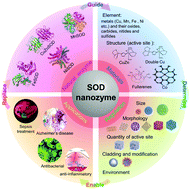Superoxide dismutase nanozymes: an emerging star for anti-oxidation
Abstract
Superoxide dismutases (SODs) are a group of metalloenzymes that catalyze the dismutation of superoxide radicals (O2˙−) into hydrogen peroxide (H2O2) and oxygen (O2). As the first line of defense against reactive oxygen species (ROS)-mediated damage, SODs are expected to play an important role in the treatment of oxidative stress-related diseases. However, the clinical applications of SODs have been severely limited by their structural instability and high cost. Compared with natural enzymes, nanozymes, nanomaterials with enzyme-like activity, are more stable, and economical, can be easily modified and their activities can be adjusted. Due to their excellent characteristics, nanozymes have attracted widespread attention in recent years and are expected to become effective substitutes for natural enzymes in many application fields. Importantly, some nanozymes with SOD-like activity have been developed and proved to have a mitigating effect on diseases caused by oxidative stress. These studies on SOD-like nanozymes provide a feasible strategy for breaking through the dilemma of SOD clinical applications. However, at present, the specific catalytic mechanism of SOD-like nanozymes is still unclear, and many important issues need to be resolved. Although there are many comprehensive reviews to introduce the overall situation of the nanozyme field, the research on SOD-like nanozymes still lacks a systematic review. From the structure and mechanism of natural SOD enzymes to the structure and regulation of SOD-like nanozymes, and then to the measurement and application of nanozymes, this review systematically summarizes the recent progress in SOD-like nanozymes. The existing shortcomings and possible future research hotspots in the development of SOD-like nanozymes are summarized and prospected. We hope that this review would provide ideas and inspirations for further research on the catalytic mechanism and rational design of SOD-like nanozymes.

- This article is part of the themed collection: Journal of Materials Chemistry B Emerging Investigators


 Please wait while we load your content...
Please wait while we load your content...